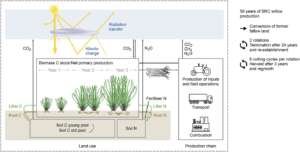Climate impact of bioenergy due to greenhouse gases and surface albedo

System components and life cycle inventory flows in the willow scenario. SRC, short‐rotation coppice
Background
Biomass as an energy source can decrease dependency on fossil fuels and contribute to climate change mitigation by storing carbon in biomass and soil. However, feedstock production gives rise to new climate impacts from land use and land conversion. Changes in albedo, the share of solar radiation reflected back from the ground, can substantially influence the life cycle climate impact of bioenergy. The more reflective a surface, the higher its albedo and the greater the potential for radiative cooling and eventually temperature change. Albedo-related cooling can go hand in hand with carbon sequestration or emission reduction. However, there is a risk that climate change mitigation focusing on greenhouse gases alone leads to suboptimal outcomes.
Aims
The aim of this work is to improve the understanding of how albedo affects the life cycle climate impact of bioenergy. This requires to compare the effects of albedo change to those of carbon sequestration and GHG emissions in a bioenergy system, and to refine the quantification of climate impacts due to albedo change in LCA.
Approaches
A scenario of growing bioenergy supply in Sweden is assumed, with minimal effects on existing land use. It comprises cultivation of short-rotation willow on previously abandoned land, transport of wood chips and combustion to produce heat and power. Using willow-based bioenergy is evaluated as a strategy to mitigate climate change.
Climate impacts are studied from a life cycle perspective, including albedo change, carbon stock changes in biomass and soil, nitrous oxide emissions from soil, and emissions related to inputs and management operations. The system is modeled using field-measured albedo and life cycle emissions data, along with time-dependent models of radiative transfer, biogenic carbon fluxes and nitrous oxide emissions from soil.
We develop a time-dependent assessment method to determine when temperature impacts will be realised, considering the timing of albedo changes and greenhouse gas fluxes and the timing of their climatic effects. This improves the relevance of LCA results to climate targets, and reflects the short-term contribution of albedo change and the long-term contribution of long-lived greenhouse gases such as CO2. GWP is used for comparison with other studies, and to illustrate how the choice of metric affects the result.
Keywords
albedo, bioenergy, willow, land use change, climate impact, LCA
Affiliation
Project leader: Per-Anders Hansson, SLU
Petra Sieber, Niclas Ericsson, SLU, Torun Hammar RISE
